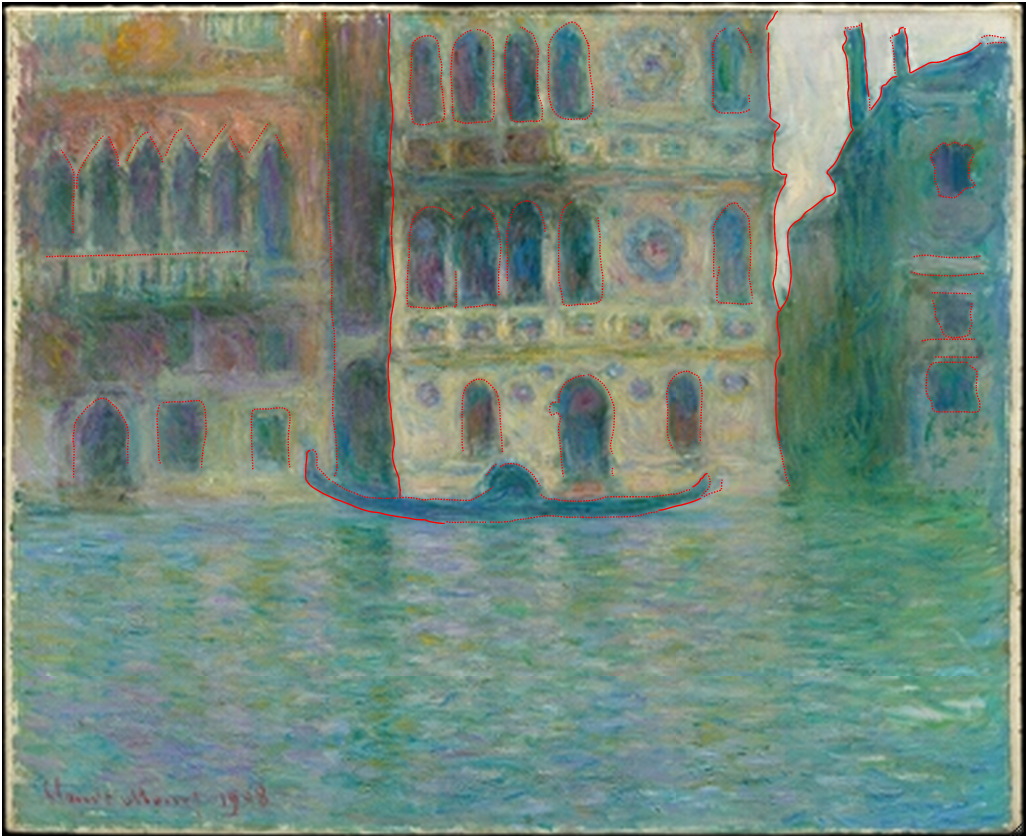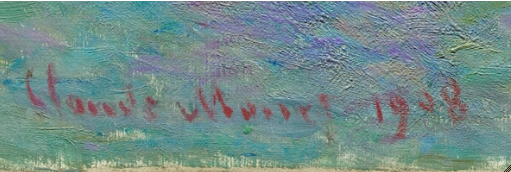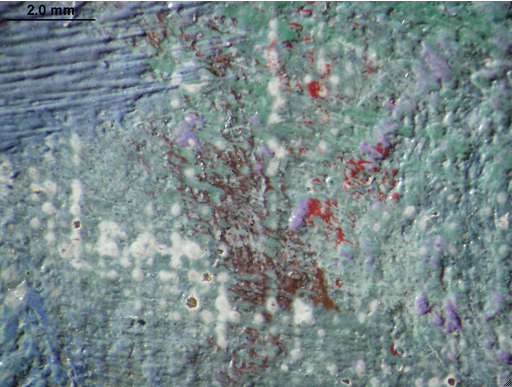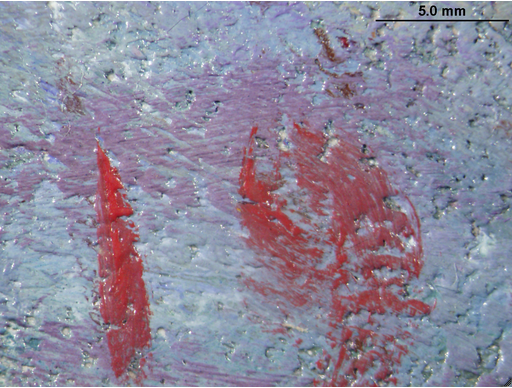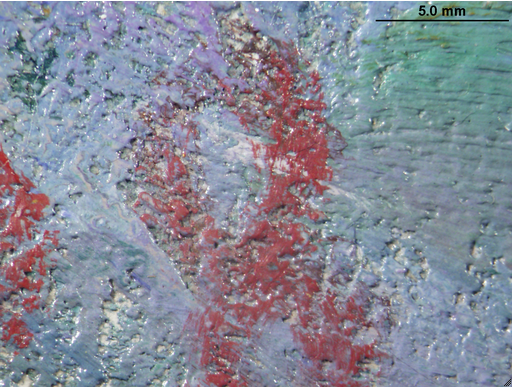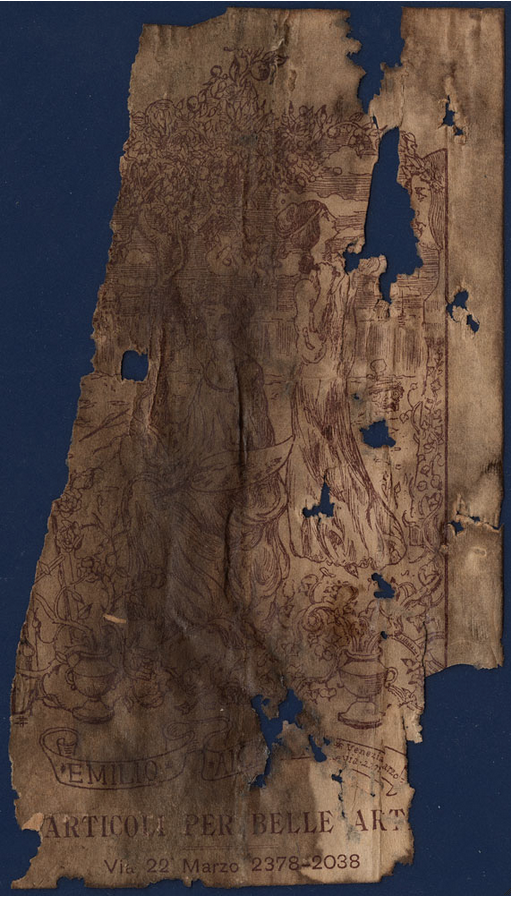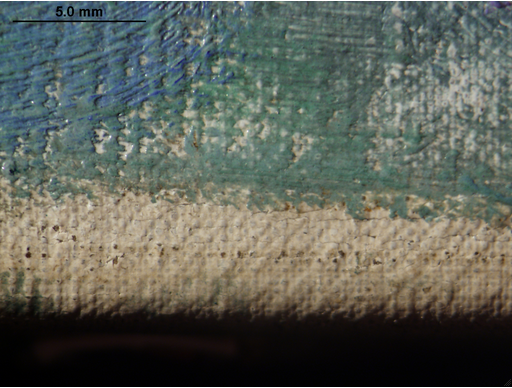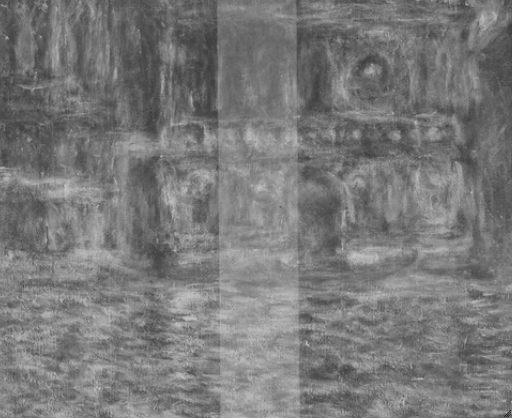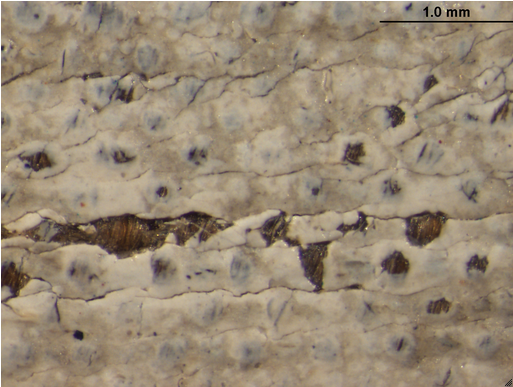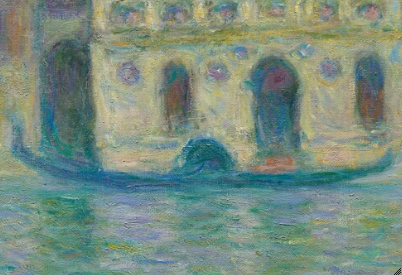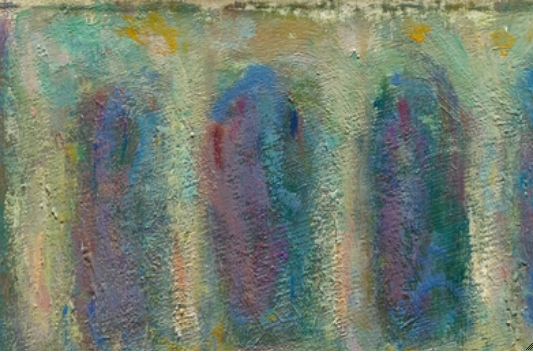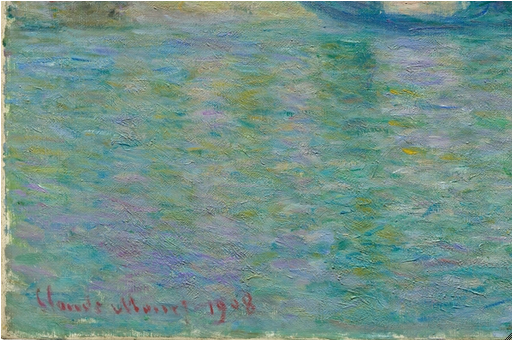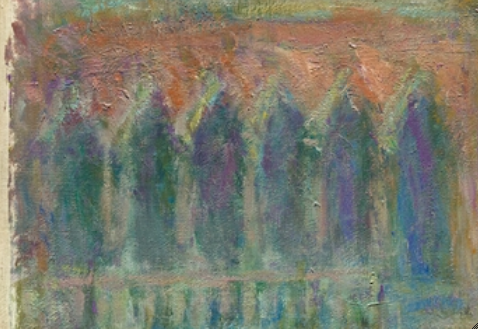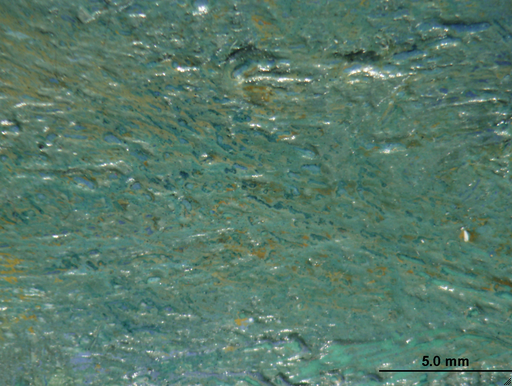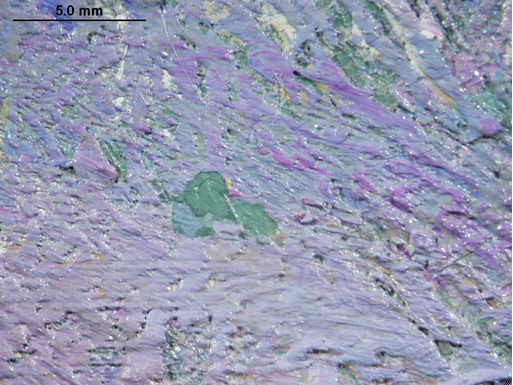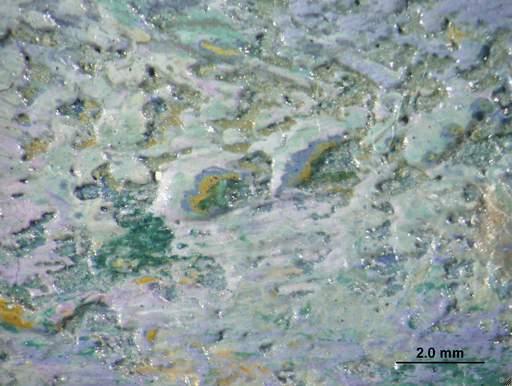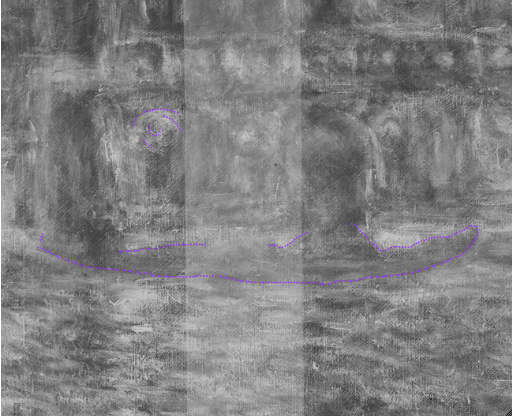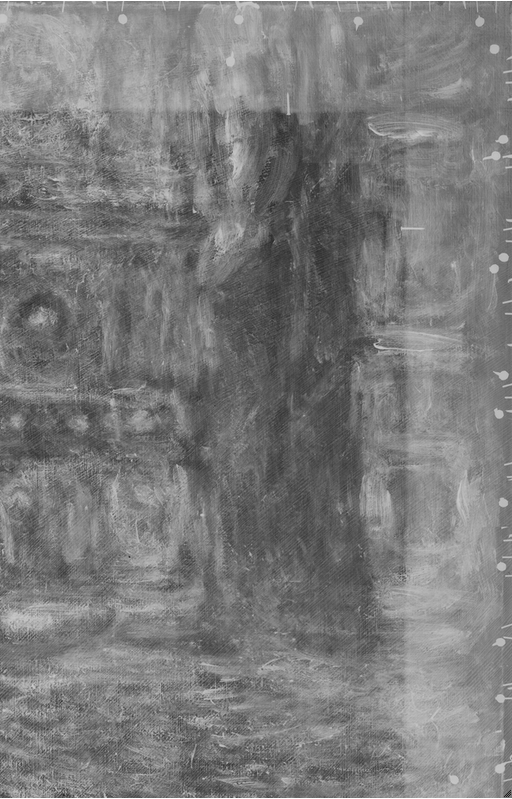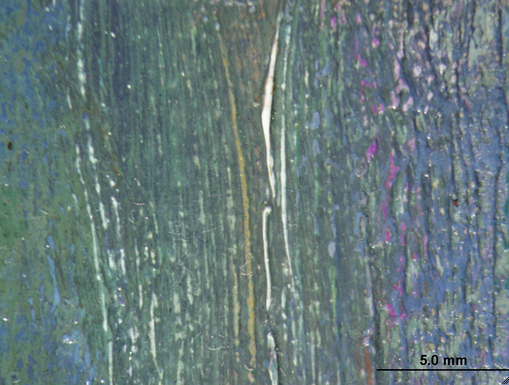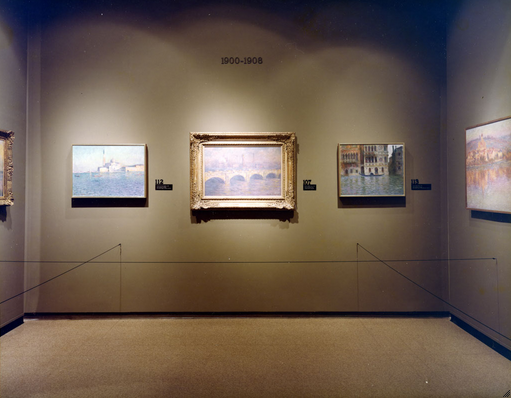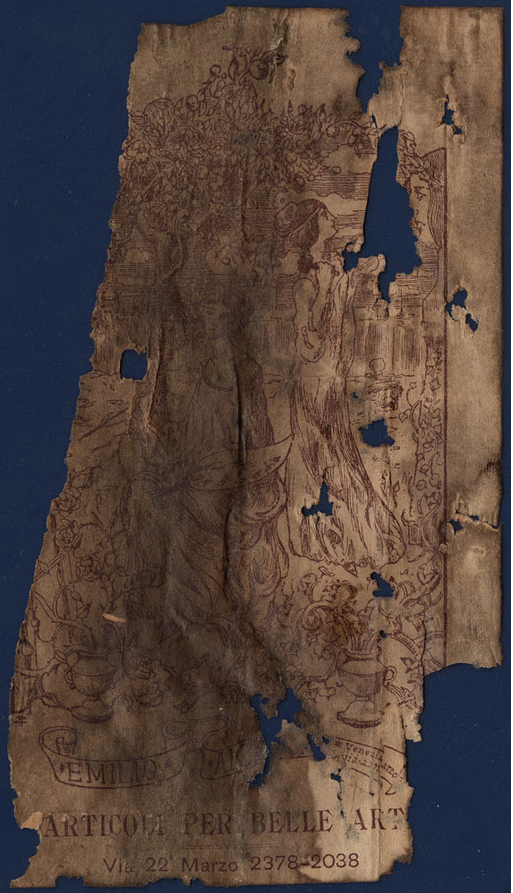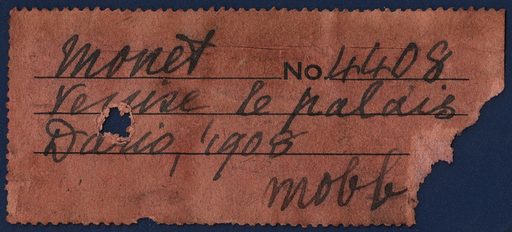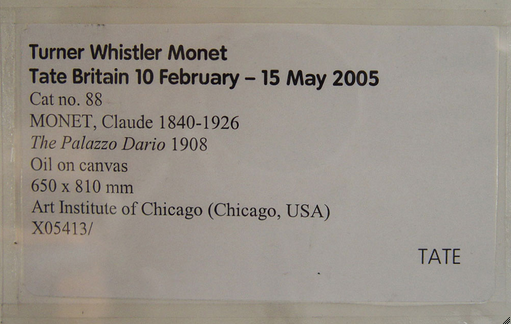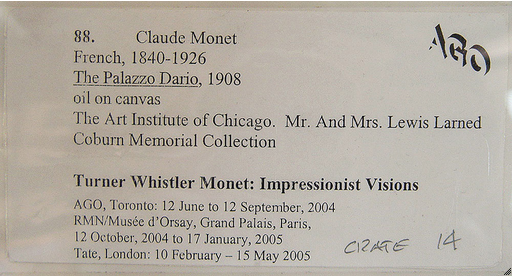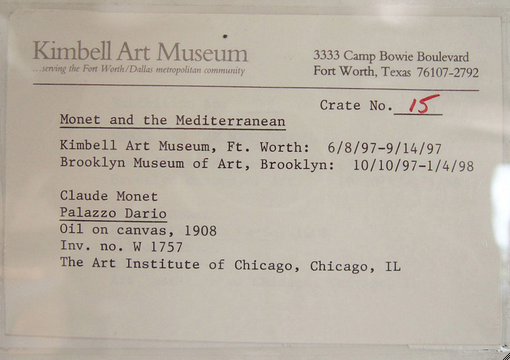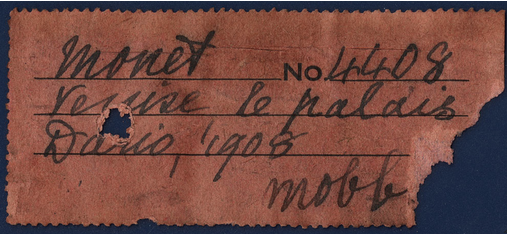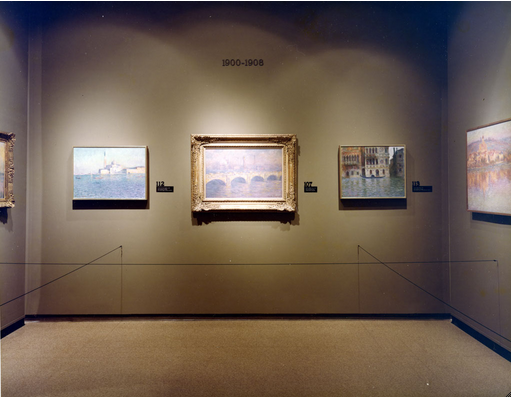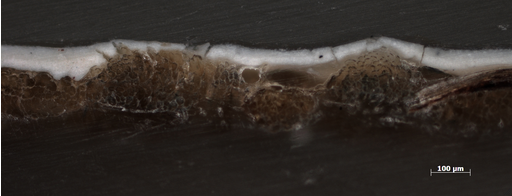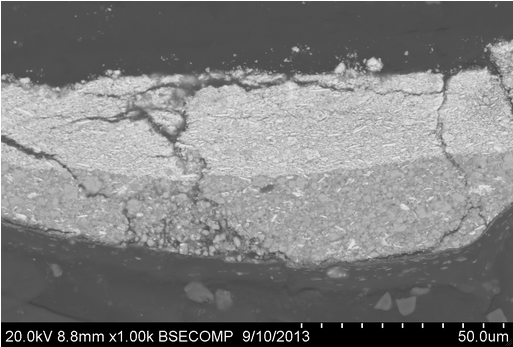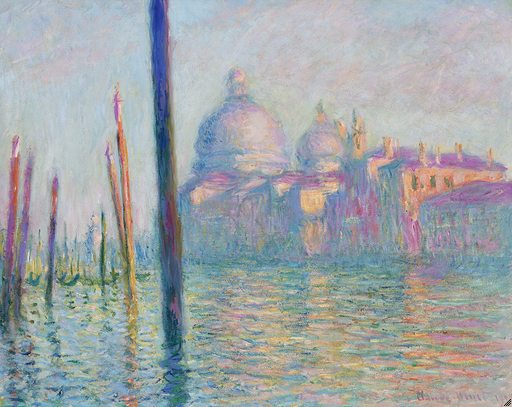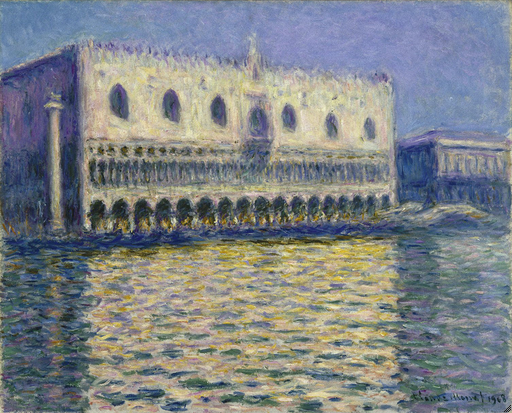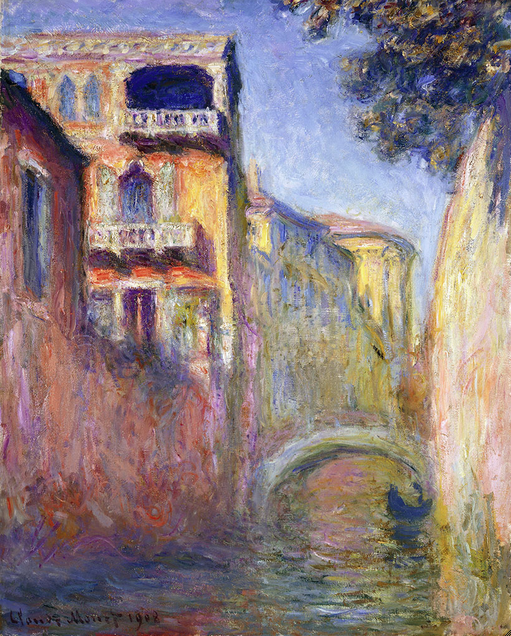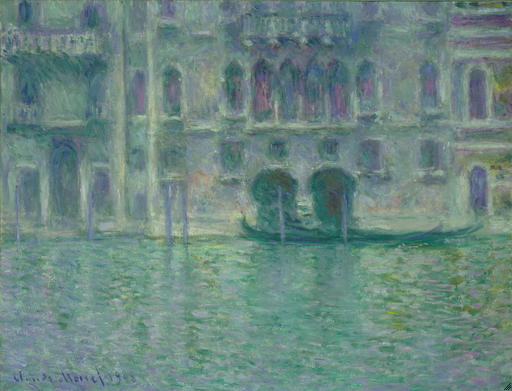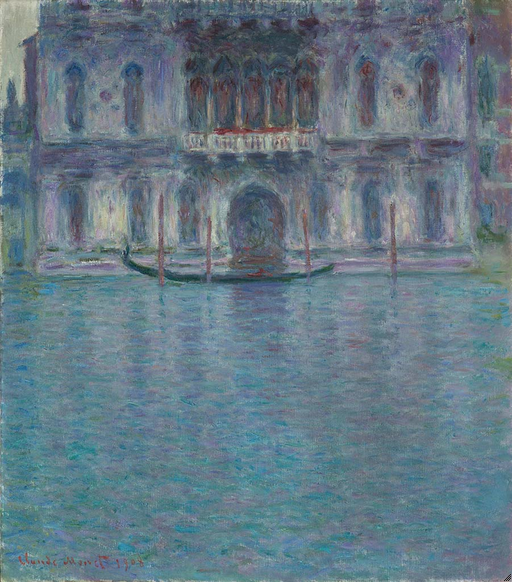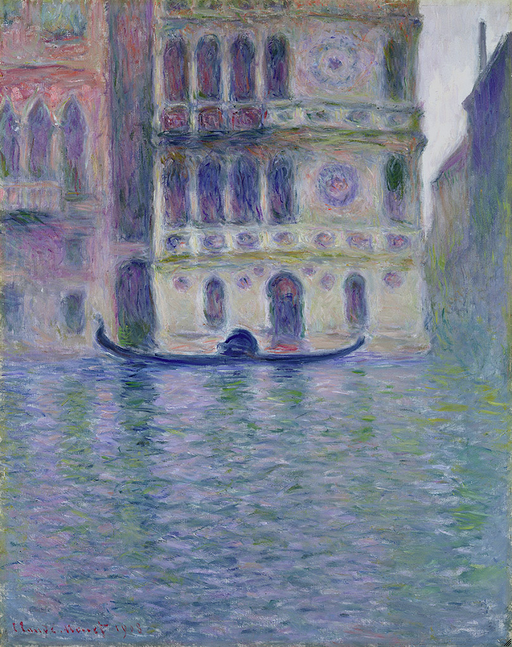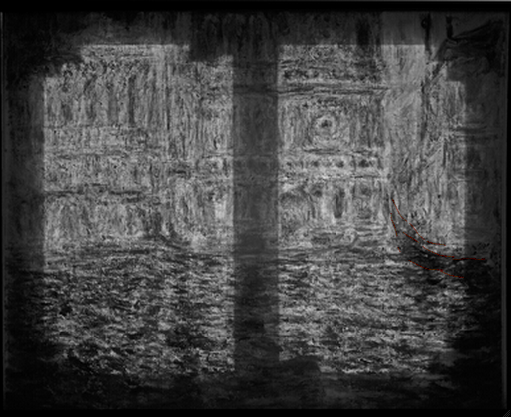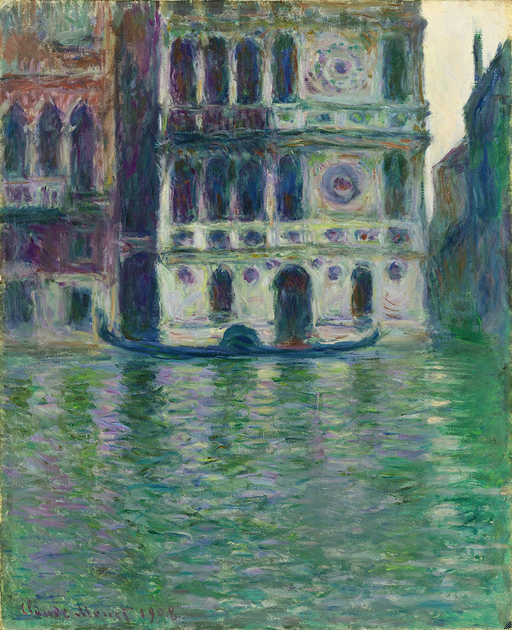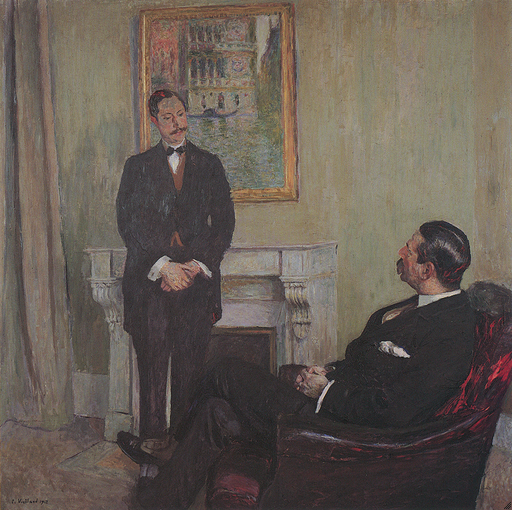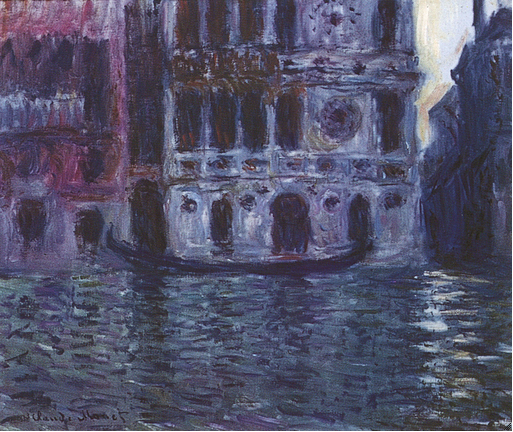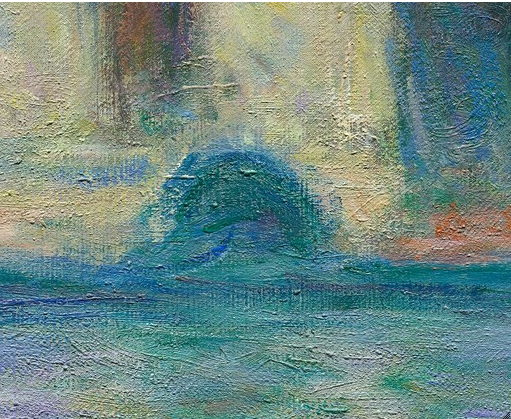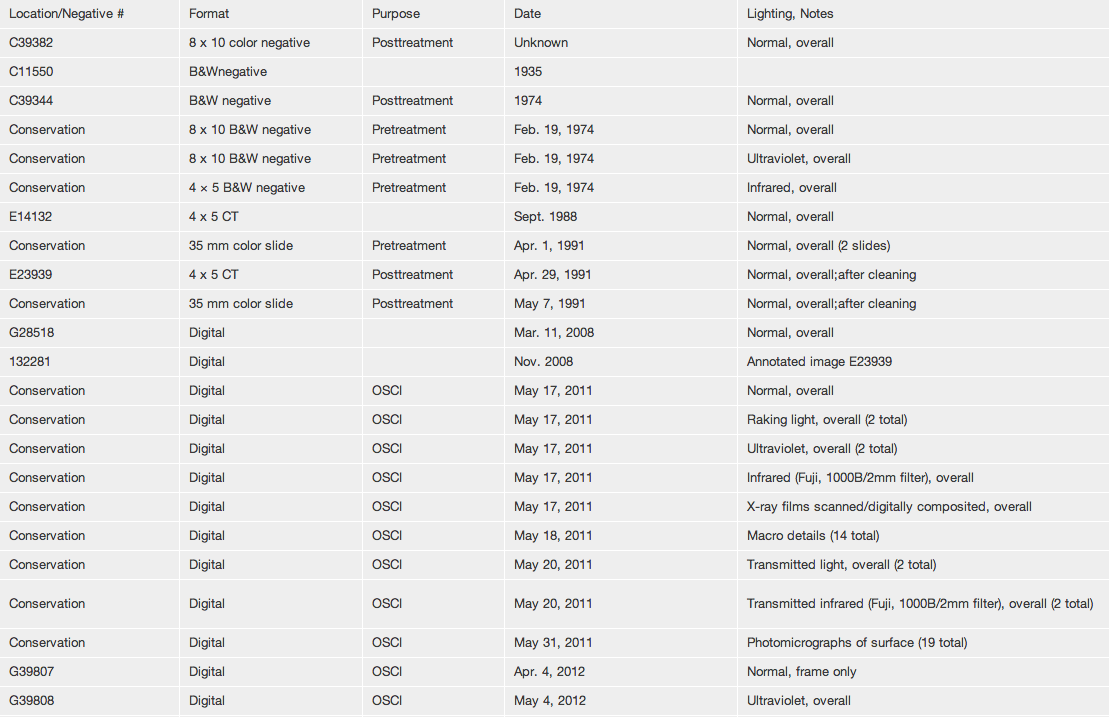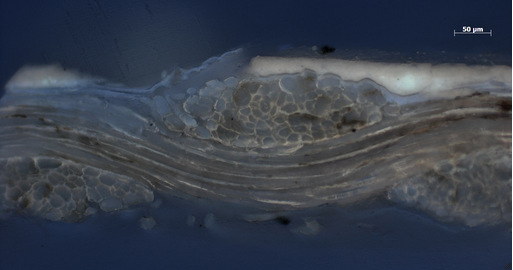Monet’s Venice
Venice, Palazzo Dario was the product of Claude Monet’s only trip to Venice, in early October to early December 1908. Monet was reluctant to visit the city, likely because it had been featured so prominently throughout the history of art and had been treated by mentors, colleagues, and friends such as J. M. W. Turner, James McNeill Whistler, Pierre-Auguste Renoir, and John Singer Sargent. At age sixty-eight, however, Monet may have assumed he would not have another opportunity to travel there, so he allowed himself to be convinced by his second wife, Alice, to accept an invitation from Mary Hunter, a British socialite, patron of the arts, and acquaintance of Sargent, who had probably introduced them when Monet was in London in 1900 and 1901 (see cats. 38–41). Hunter was staying at the Palazzo Barbaro, a fifteenth-century palace situated on the Grand Canal. Purchased by the wealthy American couple Ariana and Daniel Curtis in 1885, it became a gathering place for writers, musicians, and artists like Sargent, who in 1899 painted a portrait of the Curtis family in the salon of the palazzo; its architecture also served as the inspiration for the museum that Isabella Stewart Gardner built in Boston in 1903. In mid-September 1908 Hunter had arranged to stay there while Mrs. Curtis was attending to the estate of her husband. The Monets lodged there for two weeks before moving to the posh Hôtel Britannia, one of the most expensive hotels in the city.
The two-month trip transformed Monet’s opinion of Venice and galvanized his desire to paint the city. He began thirty-seven paintings, including the Art Institute’s Venice, Palazzo Dario, and even hoped to continue his work on another trip. He wrote his friend, the art critic Gustave Geffroy on the final day of his stay, of his planned return: “Well! [My enthusiasm for Venice] has done nothing but grow, and the moment has now come to leave this unique light. I grow very sad. It is so beautiful, but one has to see reason: many factors force us to return home. The only consolation I have is the thought of coming back here next year, for I have been able to do nothing but sketches, beginnings. But what a dreadful shame that I did not come here when I was young and would dare anything! Anyway . . . I have spent some delightful moments here and nearly forgot that I am the old man that I am!”
Venetian Struggle
Monet’s profound change of attitude toward the city can be tracked through Alice’s letters to her daughter Germaine Salerou, in which she recorded their activities on a near-daily basis. Upon their arrival, Monet declared the city “too beautiful to be painted,” she recounted; he would not even take out his brushes because the environment was “not renderable.” By October 19, however, Alice relayed that Monet had finally decided to paint; shortly after that, the artist was already writing to his dealer, Paul Durand-Ruel, that he was looking forward to returning to Venice the following year to continue serious work on his chosen motifs.
In her letters Alice also chronicled the struggles that plagued Monet throughout the Venice trip, including fluctuating weather conditions that frustrated him, as well as moments of self-doubt. Nonetheless, the Venice sojourn proved to be productive for the artist. He set up a regimented work schedule, painting between 7:45 and 8:00 in the morning until mid- to late-afternoon. Their visit also lasted much longer than they had anticipated, as evidenced by the Art Institute’s canvas. Monet had to supplement the stock of supplies he had shipped from home, presumably because he was painting more than he had originally intended. Palazzo Dario was painted on a canvas Monet purchased from Venetian art supplier Emilio Aickelin (see Technical Report/Manufacturer’s/supplier’s marks). The artist also acquired from Aickelin the sketchbook in which his only known drawing from Venice appears (fig. 45.1 [D404r]).
The Venice suite was not a formal exercise in reproducing near-identical subject matter subtly altered to reflect differences in season or lighting, as exemplified in Stacks of Wheat (see cats. 28–32), which he had executed over fifteen years earlier. Referring to his paintings of Venice, Monet himself observed that “there was not a series among the views, just different motifs repeated one, two, or three times.” The works from this trip can be organized into ten subgroups, with subjects including the Grand Canal (fig. 45.2 [W1738]), the Palazzo Ducale (fig. 45.3 [W1743]), the Church of San Giorgio Maggiore (fig. 45.4 [W1749]), and the Rio de la Salute (fig. 45.5 [1763]), painted from varying viewpoints. The Art Institute’s Venice, Palazzo Dario fits into a subgroup of frontally viewed palaces located on the Grand Canal; in addition to the Palazzo Dario, the subjects included the Palazzo da Mula (fig. 45.6 [W1764]) and the Palazzo Contarini (fig. 45.7 [W1767]). All the sites Monet selected were easily accessible from his lodgings, and it is no surprise that every picture from this trip involves the depiction of water, a standard element in conventional treatments of Venice as well as a recurring interest in Monet’s oeuvre.
Creating Tension
Monet’s effort to represent Venice, a city that seemed to float on water, is particularly striking in his paintings of palaces like Venice, Palazzo Dario. His decision to dedicate most of the bottom half of his palazzo paintings to the canal forced him to cut off the upper floors of the structures as well as the sky, which is only visible, if at all, as slivers between buildings down the narrow openings of the waterway. Octave Mirbeau’s preface to the 1912 catalogue that accompanied the first exhibition of these paintings celebrates the interplay of the light off the buildings and the waters of the canal: “The reflections pile up. One would say that the water and light gain support and strength on the façades . . . The reflection of the palaces is warm in the dense water. When the sun is high the atmosphere applies itself and sumptuously gives body to the vertical surface of the walls and the horizontal surface of the water; it is mixed with the color as though it had passed through the rose of a stained-glass window.”
Although Mirbeau’s poetic commentary suggests that the juxtaposition of the palaces and the canal waters is complementary, a tension undeniably exists in these palazzo pictures: the water and the architecture compete for space on the canvas. This is amplified by Monet’s experimentation with the formats of the works: the depictions of the Palazzo Dario and the Palazzo Contarini (see fig. 45.7) are the only ones that employ both vertically and horizontally oriented canvases. In their first exhibition at Galerie Bernheim-Jeune in Paris in 1912 (fig. 45.8 [W1758]) and fig. 45.9 [W1759]), the Art Institute’s horizontal Venice, Palazzo Dario was exhibited alongside the two vertically oriented works of the same subject. His compositional choices were also consistent throughout his working process—the one extant sketch Monet made of the Palazzo Dario features the same crowded composition, despite the fact that he had more room to expand the image on the page of the sketchbook (fig. 45.1, bottom).
The art historian Paul Tucker has suggested that Monet mystifies the elaborately designed and ornately decorated structures in the palazzo pictures, the solid, marble façades of which seem to nearly float above the canal’s waters. Tucker has also proposed that in his paintings of Venice more generally, Monet was engaging with modernist concerns. Fighting against the picturesque and cliché views by amateur artists of Venice that had proliferated with increased tourism to the city, Tucker suggests that Monet was trying to reinstate art historical weight to its motifs. By turning hackneyed subjects into studies of abstract geometry and flattened planes, Monet was attempting to reinvigorate the treatment of the city that had been so important to the history of art.
Monet’s unique viewpoint was certainly the result of his calculated selection of the locations from which he painted. Wildenstein suggests that Monet set up his easel on the opposite bank of the Grand Canal, slightly to the east of the Palazzo Corner della Ca’ Grande (the prefecture). But Monet’s unusual, and rather low, viewpoint was likely also due to the fact that he was working in a gondola. Notably, in a letter to her daughter dated November 9, 1908, Alice recorded that although that particular day had been foggy, wet, and cold, Monet—under the shelter of a covered gondola—was able to paint one of the palaces. It may have been the frame of the gondola cabin’s window that informed the way in which Monet composed his palazzo paintings.
Gondola Memories
The gondola was a recurrent theme in Alice’s correspondence home. As the art historian Stephen Eisenman has noted, “Alice was prone to additional dark reflections during the couple’s weeks in Venice. She compared their canopied, black gondola—Monet’s floating studio—to a catafalque, and brooded about being separated from the tomb of her long-dead daughter [Suzanne Hoschedé Butler].” But more often, Alice wrote about how much she enjoyed the couple’s enchanting gondola rides, which they took for both pleasure and work. She raved about the incredible skies they would see during their leisurely sunset boat trips, but also, in recounting their rigid daily routine, Alice told her daughter that she regularly accompanied Monet in the gondola while he worked, an activity that required her to remain extremely still.
Monet told the Bernheim-Jeune brothers that he would personally like to keep one of the Palazzo Dario series as a souvenir of “such happy days passed with my dear Alice.” One wonders whether Monet was specifically reminiscing about the gondolas, for they were indeed critical components of Monet’s paintings, particularly Venice, Palazzo Dario. All depictions of the structure include one large gondola at center, which—because the building itself is always slightly off center—becomes the grounding force in the disorientingly cropped scenes.
But while the gondola is an anchor in the Art Institute’s painting, it is also one of the components that may have changed significantly. Most, if not all, of the works begun in Venice required significant reworking back in his Giverny studio. These revisions certainly involved the aid of memory, imagination, and even fabrication, since they were not completed until years later, just before the 1912 exhibition, an interruption primarily due to the illness and death of Alice in 1911. Venice, Palazzo Dario indeed reveals evidence of Monet’s multiple sessions: a trace of an earlier signature and date underneath his final one suggests that he had considered the work finished in a previous session but then went back in, made adjustments, and signed it again (fig. 45.10). It is also possible that Monet moved the original placement of the gondola or potentially included more than one in an earlier stage (see Technical Report). Transmitted-infrared imaging reveals a form at center right that looks like a partial gondola gliding in or out of the picture plane (fig. 45.11), similar to the one that Monet added at left in his sketch of the motif (fig. 45.1, bottom).
It is also notable that the three Palazzo Dario pictures that were included in the 1912 exhibition are the only paintings from the campaign in which Monet included a felze, a closed cabin in the center of the boat. It does not appear in a fourth, much sketchier version of the subject (fig. 45.12 [W1760]). This picture was not included in the 1912 exhibition and may, in fact, be more representative of what the exhibited works looked like in their earlier stages. It is difficult to see from the technical images of the Art Institute’s Venice, Palazzo Dario exactly how Monet laid in the gondola. Close inspection of the surface suggests that the lower edge of the building was painted in before the cabin was added to these compositions (fig. 45.13). Alice sent a postcard of a covered gondola to her granddaughter Alice Butler (fig. 45.14), and it is tempting to suggest that Monet included the cabins as a tribute to Alice, his devoted companion who had accompanied him on his boat trips down the canals.
Monet did not return to Venice as he had hoped, and the exhibition of his Venice works was delayed until 1912, but they were a market success when they finally were presented to the public. Many of the paintings included in the Bernheim-Jeune show, including the Art Institute’s Venice, Palazzo Dario, sold quickly, suggesting the approachability of the series to collectors. One of the versions of Palazzo Dario appears in a 1912 portrait of Josse and Gaston Bernheim-Jeune by Édouard Vuillard (fig. 45.15), a reflection of the significance of Monet’s Palazzo Dario paintings to the dealers as well as the esteem in which these works were held more broadly.
Jill Shaw
Technical Report
Technical Summary
Claude Monet’s Venice, Palazzo Dario was executed on a pre-primed, no. 25 portrait (figure) standard-size linen canvas. There is a label from the Venetian supplier Emilio Aickelin on the back of the original stretcher, and this suggests that the stretched canvas was purchased in Venice. The ground is off-white and consists of two layers. The ground has a distinct diagonal, brush-marked texture, which remains visible on the surface of the painting and gives the illusion of a twill-weave canvas. The composition was built up as a whole in a network of superimposed brushstrokes, largely applied wet-in-wet. In localized areas throughout the painting, the artist wiped or scraped into the soft paint layers, exposing underlying colors. Technical imaging reveals a form in front of the building on the right that suggests an object, possibly a gondola, was included at an earlier stage in the painting. Some small adjustments were made to the gondola in the final painting. Other minor changes were made to some of the architectural details.
Multilayer Interactive Image Viewer
The multilayer interactive image viewer is designed to facilitate the viewer’s exploration and comparison of the technical images (fig. 45.16).
Signature
Signed and dated: Claude Monet 1908 (lower left corner, in red paint) (fig. 45.17).
Underneath the final signature and date, there are traces of an earlier signature and date, executed in brown paint (fig. 45.18). The brown paint appears to have been partially wiped or scraped away, as it is very thin and abraded in places (fig. 45.19). Some strokes from the water were applied on top before the final signature and date were applied (fig. 45.20). The first signature appears to have been similar in size and placement to the final one, and the date appears to have been the same, as the contours of the 8 can be discerned under magnification (fig. 45.21).
Structure and Technique
Support
Canvas
Flax (commonly known as linen).
Standard format
The original dimensions were approximately 65.5 × 80.5 cm. This corresponds closely to a no. 25 portrait (figure) standard-size canvas (81 × 65 cm), turned horizontally.
Weave
Plain weave. Average thread count (standard deviation): 33.4V (1.1) × 33.0H (0.5) threads/cm; the horizontal threads were determined to correspond to the warp and the vertical threads to the weft. No weave matches were found with other Monet canvases analyzed for this project.
Canvas characteristics
There is strong cusping along the top edge, mild, relatively even cusping on the left and right edges, and only faint indications of cusping along the bottom.
Stretching
Current stretching: Dates to 1991 treatment. Copper tacks spaced 2.5–5 cm apart. There is a series of smaller holes, spaced approximately 3–5 cm apart, which probably relates to the aluminum strip molding applied in 1959. The top edge was restretched in 2002 to deal with some deformations in the canvas (see Conservation History).
Original stretching: Tack holes spaced approximately 3–6 cm apart. The cusping appears to correspond to the placement of the old tack holes on the left, right, and bottom edges, but not along the top edge. Additional tacks were probably subsequently added to reinforce areas of weak attachment where the original holes were degraded.
Stretcher/strainer
Current stretcher: Dates to 1991 conservation treatment (see Conservation History). It is a five-membered (with vertical crossbar), keyable stretcher with mortise and tenon joints.
Original stretcher: Discarded. The pre-1974-treatment stretcher may have been the original stretcher. It was described in an undated report as a four-membered, Buck type 2 stretcher with keyable mortise and tenon joints. This report gives the following dimensions: overall, 66 × 81 cm; outside depth, 2 cm; width, 5 cm; inside depth, 2 cm; distance from canvas position, 0.5 cm; length of mortise, 5 cm.
Manufacturer’s/supplier’s marks
A supplier’s label from the back of the pre-1974-treatment stretcher (discarded) is preserved in the conservation file: EMILIO AICK[ELIN] / Venezia / Via 22 Marzo / ARTICOLI PER BELLE ART[. . .] / Via 22 Marzo 2378-2038 (fig. 45.22).
Preparatory Layers
Sizing
In UV light, evidence of a light-blue fluorescence between the canvas and the ground suggests the presence of an organic layer, possibly glue sizing (fig. 45.23).
Ground application/texture
The ground layer extends to the edges of all four tacking margins, suggesting that the canvas was cut from a larger piece of primed fabric, which was probably commercially prepared. There is strong diagonal brushmarking (lower left to upper right) on the surface of the ground layer, which is visible where the ground is exposed at the edges of the painting (fig. 45.24) and also in the X-ray (fig. 45.25). The diagonal brushstrokes appear to continue over the tacking margins to the cut edges of the canvas (fig. 45.26). The width of the sweeping brushstrokes suggests that a fairly broad brush was used. Cross-sectional analysis indicates that the ground consists of two layers. The lower layer ranges from approximately 10 to 45 µm in thickness. The upper layer ranges from approximately 20 to 55 µm in thickness (fig. 45.27, fig. 45.28).
Color
Off-white, with some dark and possibly red particles visible under magnification (fig. 45.29).
Materials/composition
Analysis indicates that the lower layer contains lead white with minor amounts of zinc white and barium sulfate and traces of silica, silicates, and calcium carbonate. The upper layer contains lead white with traces of barium sulfate, iron oxide, calcium-based white, silica, and silicates.
Compositional Planning/Underdrawing/Painted Sketch
Extent/character
No underdrawing was observed with infrared reflectography (IRR) or microscope examination.
Paint Layer
Application/technique and artist’s revisions
Although the ground layer is almost completely obscured by the relatively thick and continuous buildup of paint layers, the pronounced diagonal, brush-marked texture of its surface remains visible throughout the painting, almost giving the appearance of a twill-weave canvas. The ground texture is most noticeable where the paint is thin or lightly dragged across the surface, often at the borders of compositional elements, for example, around the doors and windows (fig. 45.30, fig. 45.31, fig. 45.32). At the same time, the plain-weave texture of the canvas is also visible on the paint surface in some areas. The buildup of the paint, where it was applied in a horizontal direction and with a light touch, often emphasizes the vertical canvas threads, creating a corrugated texture (fig. 45.33).
The painting appears to have been worked up from a thin lay-in of the composition. Where the earliest layers are visible, the artist seems to have mapped out the composition with more subdued tones, applied in thin layers. In the water, for example, transparent strokes of thinly applied green and greenish-blue paint were laid in first. The water was then built up with individual strokes of different colors, often applied wet-on-wet with little physical mixing or blending of the colors on the canvas (fig. 45.34). Some of the final strokes applied in the water consist of more intense color, lightly dragged across the surface (fig. 45.35). Although the painting is densely built up, the surface is relatively flat, with only low-relief texture, which often comes from beneath the surface from the ground and canvas textures and the crisp brushmarks of underlying layers. There is no impasto and only a few thick, textural strokes scattered over the surface. Both the positive and negative spaces of the architecture were built up to the same degree and sit basically on the same plane (fig. 45.36, fig. 45.37). Throughout the painting, it appears that the artist wiped or scraped into the upper paint layers in localized areas, revealing underlying colors (fig. 45.38, fig. 45.39, fig. 45.40) as well as the ground and canvas in places (fig. 45.19). This was perhaps done as a way of breaking up more solid areas of color, and it also contributes to the flattened appearance of the paint surface. It is difficult to say how the scraping or wiping was carried out, as no actual tool marks are evident, but it appears to have been done when the upper layers were still soft (fig. 45.41) and sometimes offers a cross-sectional view of superimposed paint layers in small areas (fig. 45.42).
Underlying brushwork at the base of the building on the right, visible in transmitted infrared, suggests that the artist made changes in this area (fig. 45.43). The curved brushstrokes are suggestive of a gondola but could also be related to adjustments made to the building where it meets the water. The paint applied on top is slightly more solid and opaque than the more open brushwork of the rest of the water (fig. 45.44). If the earlier brushwork did represent a boat, it is difficult to say whether both boats were present simultaneously in the composition at any stage. The central boat does, however, appear to have been part of the composition from early on, based on its relative radio-transparency in the X-ray (fig. 45.45), which shows that the water and the features of the palazzo behind were built up around it. It appears that the boat in the final painting was extended on the left side where it continues on top of the building. Other minor changes involve the door and window of the building on the left, both of which were moved further to the right (fig. 45.46). Similarly, the small, circular feature on the left side of the lower level of Palazzo Dario was shifted slightly to the lower left (fig. 45.47). The architectural features of the building on the right appear to have been laid in much more distinctly compared to their final appearance. This is apparent in the X-ray, in which strong, directional, lead white–rich strokes delineating the different stories and window openings of the building are clearly visible. In the final painting, these features have been largely subdued by the thin, sketchy brushwork on the surface (fig. 45.48). The thicker, more textured underlayers were dry when the upper layers were applied; the crisp ridges of those earlier brushstrokes remained undisturbed when subsequent paint layers were applied and when localized areas were subjected to the scraping/wiping technique discussed above (fig. 45.49). This supports the idea that the painting was carried out in more than one session.
Painting tools
Brushes, including 0.5 and 1.0 cm width, flat ferrule (based on width and shape of brushstrokes). Possible scraping of paint layers may have involved the use of a palette knife, but no tool marks could be discerned. Several brush hairs are embedded in the paint layer.
Palette
Analysis indicates the presence of the following pigments: lead white, cadmium yellow, strontium yellow, vermilion, red lake, viridian, malachite, cerulean blue, cobalt blue, cobalt violet, and possibly zinc white.
Binding media
Oil (estimated).
Surface Finish
Varnish layer/media
The synthetic varnish that was applied in the 1974 treatment was thinned in 1991 (see ). Since the treatment report states that this coating was “thinned,” it is likely that some synthetic varnish residues remain on the surface (see Conservation History). The paint surface has a soft sheen in areas where the paint is thicker and smooth, and it appears more matte where the paint is thinly applied and the canvas texture is visible. According to a 1959 examination report, the painting was unvarnished at that time.
Conservation History
In 1959, the painting (described as unvarnished at the time) was surface cleaned, and a spray coat of equal parts methacrylate L44 and L46 was applied. The painting was backed with a resin-coated hardboard and aluminum strip molding was attached to the edges.
In 1974, discolored surface films were removed. The painting was wax-resin lined and restretched on an ICA spring stretcher. A layer of polyvinyl acetate (PVA) AYAA was applied. Inpainting was carried out. A layer of methacrylate resin L-46 was applied, followed by a final layer of AYAA.
In 1991, the synthetic resin coating was reduced. The wax-resin lining was removed. Weak areas of the tacking margins were reinforced, and a small puncture in the center of the canvas was reinforced and filled. The tacking margins were strip lined. The painting was restretched on a new stretcher with a loose lining. The painting was keyed out, and the keys were secured. A Fome-Cor backing board was applied.
In 2002, the painting was restretched on the top edge to ameliorate ripples in the canvas, and the stretcher was keyed out. Wedge retainers were added to keep the keys in place.
Condition Summary
The painting is in good condition. The canvas has a loose lining, and the tacking edges are strip lined (the 1974 wax-resin lining was removed in 1991). The canvas is fairly taut on the stretcher and there are no planar deformations. The tacking margins are deteriorated and torn at the old tack holes and the corners. In general, the ground layer is moderately abraded and dirty along the edges. The paint layer is stable. There are a few, tiny flake losses: at lower right in the water; to the left of the door of the Palazzo Dario (documented as a small puncture in the 1991 treatment report); above the upper arched windows of the left building; and a vertical series at the upper right edge, which may be the result of a scratch or impact. There is a light scratch, made when the paint was still soft, near the center of the large area of sky. There is only very light cracking scattered throughout the paint surface, mainly spanning thicker strokes of paint. The painting is unvarnished and has a subtle, variable surface sheen depending on the qualities of the paint and the brushwork. There are residues of starch paste and wax-resin adhesive from the 1974 lining procedure in the recesses of the paint texture throughout the surface. There are some old retouching residues around the edges of the painting.
Kimberley Muir
Frame
Current frame (installed 1991): The frame is not original to the painting. It is an American reproduction of a Louis XIII convex frame with a running acanthus-leaf ornament with acanthus-leaf miters and a ribbon and cove sight (APF Inc., New York, 1991). The frame is water gilded over red-brown bole on gesso. The hollow is burnished, with selective burnishing on the carved ornament. The gold has been heavily rubbed overall and toned with thin oil paint washes, casein washes, and dark flecking. The carved basswood moldings are mitered and nailed. The molding, from perimeter to interior, is cove; scotia, convex face with a running acanthus-leaf ornament with acanthus-leaf miters on a recut bed; fillet; hollow; fillet; torus with a ribbon ornament; and cove (fig. 45.50).
Previous frame (installed by 1975; removed 1991): The work was previously housed in an American, mid-twentieth-century, L-shaped, narrow frame with a gilded face on a mahogany molding with exposed splines at the miters. The frame may be a design by James L. Speyer (fig. 45.51).
Previous frame (installed before 1922; date removed, unknown) The work was previously housed in what was probably the original frame, a French (Parisian), early-twentieth-century, Durand-Ruel, Régence Revival, ogee frame with cast foliate and center cartouches with cabochon centers on a quadrillage bed, leaf-tip-and-shell sight molding, and a independent fillet liner (fig. 45.52).
Kirk Vuillemot
Provenance
Sold by the artist, in half-shares, to Bernheim-Jeune, Paris, and Durand-Ruel, Paris, Apr. 10, 1912, for 10,000 francs.
Sold to Durand-Ruel, New York, Oct. 11, 1912, or Oct. 17, 1912.
Sold by Durand-Ruel, New York, to Arthur B. Emmons, Newport, Rhode Island, Dec. 26, 1912, for $7,500.
Sold by Arthur B. Emmons, Newport, Rhode Island, to Durand-Ruel, New York, May 27, 1913, for 37,600 francs.
Sold by Durand-Ruel, New York, to Arthur B. Emmons, Newport, Rhode Island, May 27, 1913, for $6,500.
Sold at the Arthur B. Emmons, Newport, Rhode Island, sale, American Art Association, New York, Jan. 14, 1920, lot 42, to Durand-Ruel, New York, and Knoedler, New York, in half-shares, for $5,800.
Sold by Durand-Ruel, New York, to Mrs. Lewis Larned (Annie Swan) Coburn, Chicago, Feb. 8, 1923, for $9,735 + tax.
Bequeathed by Mrs. Lewis Larned (Annie Swan) Coburn (died 1932), Chicago, to the Art Institute of Chicago, 1933.
Exhibition History
Paris, Bernheim-Jeune, Claude Monet: “Venise,” May 28–June 8, 1912, cat. 19, as Le Palais Dario.
Boston, Brooks Reed Gallery, Monet. Venise, late Oct. 1912.
Boston, Brooks Reed Gallery, Tableaux Durand-Ruel, Mar. 1921.
Art Institute of Chicago, Exhibition of the Mrs. L. L. Coburn Collection: Modern Paintings and Watercolors, Apr. 6–Oct. 9, 1932, cat. 26.
Art Institute of Chicago, ”A Century of Progress”: Loan Exhibition of Paintings and Sculpture for 1934, June 1–Oct. 31, 1934, cat. 221.
University of Chicago, Lexington Hall, Nov. 28–Dec. 19, 1951, no cat.
Chicago, Remington Rand, window display, Apr. 14–30, 1952, no cat.
University of Chicago, Lexington Hall, Mar. 1–20, 1954, no cat.
University of Chicago, Lexington Hall, Feb. 25–Mar. 11, 1955, no cat.
University of Chicago, College of Humanities, Feb. 27–Mar. 16, 1956, no cat.
Park Forest (Ill.) Art Center, Mar. 25–Apr. 22, 1956, no cat.
Art Center in La Jolla (Calif.), Great French Paintings, 1870–1910, June 15–July 26, 1956, cat. 10 (ill.).
Art Institute of Chicago, The Paintings of Claude Monet, Apr. 1–June 15, 1957, no cat. no.
New York, Museum of Modern Art, Claude Monet: Seasons and Moments, Mar. 9–May 15, 1960, cat. 97; Los Angeles County Museum, June 14–Aug. 7, 1960.
Art Institute of Chicago, Paintings by Monet, Mar. 15–May 11, 1975, cat. 113 (ill.). (fig. 45.53)
Fort Worth, Tex., Kimbell Art Museum, Monet and the Mediterranean, June 8–Sept. 7, 1997, cat. 93 (ill.); New York, Brooklyn Museum of Art, Oct. 10, 1997–Jan. 4, 1998.
Toronto, Art Gallery of Ontario, Turner; Whistler; Monet, June 12–Sept. 12, 2004, cat. 88 (ill.); Paris, Galeries Nationales du Grand Palais, Oct. 12, 2004–Jan. 17, 2005; London, Tate Britain, Feb. 10–May 15, 2005.
Fort Worth, Tex., Kimbell Art Museum, The Impressionists: Master Paintings from the Art Institute of Chicago, June 29–Nov. 2, 2008, cat. 89 (ill.).
Rouen, Musée des Beaux-Arts, Éblouissants reflets: Cent chefs-d’oeuvre impressionnistes, Apr. 29–Sept. 30, 2013, cat. 155 (ill.).
Selected References
Bernheim-Jeune, Claude Monet: “Venise,” with a preface by Octave Mirbeau, exh. cat. (Bernheim-Jeune, [1912]), cat. 19.
Gustave Geffroy, “La Venise de Claude Monet,” La dépêche de Toulouse, May 30, 1912, p. 1.
“Art et curiosité: Une féerie de lumière et de couleur; Venise vue par Cl. Monet,” Le temps, June 11, 1912, p. 4.
Henri Genet, “Beaux-Arts et curiosité. Les ‘Venise’ de Cl. Monet,” L’opinion, June 1, 1912, p. 698.
“Revue des ventes. New York,” Le journal des arts, Feb. 21, 1920, p. 3.
“Collections Emmons, Flanagan Sayles et autres à New York,” La chronique des arts 4 (Feb. 29, 1920), p. 32.
Gustave Geffroy, Claude Monet: Sa vie, son temps, son oeuvre (G. Crès, 1922), opp. p. 312 (ill.).
Art Institute of Chicago, Exhibition of the Mrs. L. L. Coburn Collection: Modern Paintings and Watercolors, exh. cat. (Art Institute of Chicago, 1932), p. 20, cat. 26.
Art Institute of Chicago, Catalogue of “A Century of Progress”: Exhibition of Paintings and Sculpture, 1934, ed. Daniel Catton Rich, exh. cat. (Art Institute of Chicago, 1934), p. 38, cat. 221.
Oscar Reuterswärd, Monet: En konstnärshistorik (Bonniers, 1948), pp. 254, fig. 121; 255; 288.
Art Center in La Jolla, Great French Paintings, 1870–1910, exh. cat. (Art Center in La Jolla, 1956), p. 13, cat. 10 (ill.).
Art Institute of Chicago, “Catalogue,” Art Institute of Chicago Quarterly 51, 2 (Apr. 1, 1957), p. 34.
William C. Seitz, Claude Monet: Seasons and Moments, exh. cat. (Museum of Modern Art, New York/Los Angeles County Museum of Art/Doubleday, 1960), p. 63, cat. 97.
Art Institute of Chicago, Paintings in the Art Institute of Chicago: A Catalogue of the Picture Collection (Art Institute of Chicago, 1961), p. 322.
A. James Speyer, “Twentieth-Century European Paintings and Sculpture,” Apollo 84, 55 (Sept. 1966), p. 222.
Susan Wise, ed., Paintings by Monet, exh. cat. (Art Institute of Chicago, 1975), p. 170, cat. 113 (ill.).
A. James Speyer and Courtney Graham Donnell, Twentieth-Century European Paintings (University of Chicago Press, 1980), p. 59, cat. 3B4; microfiche 3, no. B4 (ill.).
Daniel Wildenstein, Claude Monet: Biographie et catalogue raisonné, vol. 4, Peintures, 1899–1926 (Bibliothèque des Arts, 1985), pp. 240; 241, cat. 1757 (ill.); 385, letter 2012a; 430, pièces justificatives 239, 240, 241; 431, pièce justificative 294; 432, pièce justificative 313.
Daniel Wildenstein, Claude Monet: Catalogue raisonné, vol. 5, Supplément aux peintures: Dessins; Pastels; Index (Wildenstein Institute, 1991), p. 118, cat. D404.
Andrew Forge, Monet, Artists in Focus (Art Institute of Chicago, 1995), pp. 65; 103, pl. 32; 109.
Daniel Wildenstein, Monet, or The Triumph of Impressionism, cat. rais., vol. 1 (Taschen/Wildenstein Institute, 1996), p. 389, cat. 1757 (ill.).
Daniel Wildenstein, Monet: Catalogue raisonné, vol. 4, Nos. 1596–1983 et les grandes décorations (Taschen/Wildenstein Institute, 1996), pp. 822–24, cat. 1757 (ill.).
Pablo García Sainz, ed., “Los Pintores de Venecia,” Saber ver: Lo contemporáneo del arte 37 (Nov.–Dec. 1997), pp. 71, 72 (ill.).
Joachim Pissarro, Monet and the Mediterranean, exh. cat. (Kimbell Art Museum/Rizzoli, 1997), pp. 164; 167, pl. 93.
Matthias Arnold, Claude Monet, Rowohlts Monographien (Rowohlt, 1998), p. 141 (ill.). Translated by Anne Wyburd, Monet (Haus, 2005), p. 145 (detail).
Norio Shimada and Keiko Sakagami, Kurōdo Mone meigashū: Hikari to kaze no kiseki [Claude Monet: 1881–1926], vol. 2 (Nihon Bijutsu Kyōiku Sentā, 2001), pp. 130, no. 253 (ill.); 191.
Katharine Lochnan, “Turner, Whistler, Monet: An Artistic Dialogue,” in Turner; Whistler; Monet: Impressionist Visions, ed. Katharine Lochnan, exh. cat. (Art Gallery of Ontario/Tate Publishing, 2004), p. 35.
John House, “Tinted Steam: Turner and Impressionism,” in Turner; Whistler; Monet: Impressionist Visions, ed. Katharine Lochnan, exh. cat. (Art Gallery of Ontario/Tate Publishing, 2004), p. 49.
Sylvie Patin, “The Last Act: Turner, Whistler and Monet in Venice,” in Turner; Whistler; Monet: Impressionist Visions, ed. Katharine Lochnan, exh. cat. (Art Gallery of Ontario/Tate Publishing, 2004), pp. 206; 212; 213, no. 88; 214, no. 88 (ill.).
Stephen F. Eisenman, “Death and Tourism: Claude Monet’s Paintings of Venice,” in Value: Art: Politics: Criticism, Meaning and Interpretation after Postmodernism, ed. Jonathan Harris (Liverpool University Press, 2007), p. 141, fig. 11.
Gloria Groom and Douglas Druick, with the assistance of Dorota Chudzicka and Jill Shaw, The Impressionists: Master Paintings from the Art Institute of Chicago, exh. cat. (Art Institute of Chicago/Kimbell Art Museum, 2008), p. 171, cat. 89 (ill.). Simultaneously published as Gloria Groom and Douglas Druick, with the assistance of Dorota Chudzicka and Jill Shaw, The Age of Impressionism at the Art Institute of Chicago (Art Institute of Chicago/Yale University Press, 2008), p. 171, cat. 89 (ill.).
Philippe Piguet, Monet et Venise, rev. and complete ed. (Herscher, 2008), pp. 110-11 (ill.).
Ségolène Le Men, “Un horizon de peinture,” in Sylvain Amic, Eblouissants reflets: Cent chefs-d’œuvre impressionnistes, exh. cat. (Réunion des Musées Nationaux-Grand Palais/Musée de la Ville de Rouen, 2013), pp. 281; 284, cat. 155 (ill.).
Other Documentation
Documentation from the Durand-Ruel Archives
Inventory number
Stock Durand-Ruel Paris 10000, Durand-Ruel, Paris stock book 1901–13
Inventory number
Stock Durand-Ruel New York 3542, Durand-Ruel, New York stock book 1904–24
Inventory number
Stock Durand-Ruel New York 3647, Durand-Ruel, New York stock book 1904–24
Inventory number
Stock Durand-Ruel New York 4408, Durand-Ruel, New York stock book 1904–24
Photograph number
Durand-Ruel Paris Photo no. 7266
Other Documents
Label (fig. 45.54)
Documentation from the Bernheim-Jeune Archives
Inventory number
Stock Bernheim-Jeune 19267
Labels and Inscriptions
Pre-1980
Label
Location: pre-1974-treatment stretcher (discarded); preserved in conservation file
Method: printed label
Content: EMILIO AICK[ELIN] / Venezia / Via 22 Marzo / ARTICOLI PER BELLE ART[. . .] / Via 22 Marzo 2378-2038 (fig. 45.55)
Label
Location: pre-1974-treatment stretcher (discarded); preserved in conservation file
Method: printed label with handwritten script
Content: Monet No. 4408 / Venise, le palais / Dario, 1908 / mobb (fig. 45.56)
Post-1980
Label
Location: backing board
Method: printed label with typewritten script
Content: THE ART INSTITUTE OF CHICAGO / artist Claude Monet / title “Venice, Palazzo Dario” 1908 / medium oil on canvas / credit Mr. and Mrs. Lewis Larned Coburn / acc. # 1933.446 / LZ-341-001 1M 1/90 (REV. 1/90) (fig. 45.57)
Label
Location: backing board
Method: printed label with handwritten script
Content: Panel Insert / Installation Date / 2.20.2008 (fig. 45.58)
Label
Location: backing board
Method: printed label with handwritten script
Content: Panel Insert / Installation Date / 2.20.2008 (fig. 45.59)
Label
Location: backing board
Method: printed label with handwritten script
Content: [logo] / Réunion des musées nationaux / Exposition: Turner, Whistler, Monet / Lieu: Paris / Dates: 12/10/2004–17/01/2005 / Titre de l’oeuvre: Le Palais Dario / Auteur: Monet (Claude) / No catalogue: 95 [crossed out in ink and replaced with] 89 / Propriétaire: The Art Institute of Chicago (fig. 45.60)
Label
Location: backing board
Method: printed label
Content: Turner Whistler Monet / Tate Britain 10 February–15 May 2005 / Cat. no. 88 / MONET, Claude 1840–1926 / The Palazzo Dario 1908 / Oil on canvas / 650 × 810 mm / Art Institute of Chicago (Chicago, USA) / X05413/ / TATE (fig. 45.61)
Label
Location: backing board
Method: printed label with handwritten script
Content: 88. Claude Monet / AGO [logo] / French 1840–1926 / The Palazzo Dario, 1908 / oil on canvas / The Art Institute of Chicago. Mr. and Mrs. Lewis Larned / Coburn Memorial Collection / Turner Whistler Monet: Impressionist Visions / AGO, Toronto: 12 June to 12 September, 2004 / RMN/Musée d’Orsay, Grand Palais, Paris, / 12 October, 2004 to 17 January, 2005 / Tate, London: 10 February–15 May 2005 / CRATE 14 (fig. 45.62)
Label
Location: backing board
Method: printed label with typewritten and handwritten script (there appears to be another label underneath)
Content: Kimbell Art Museum / . . . serving the Fort Worth/Dallas metropolitan community / 3333 Camp Bowie Boulevard / Fort Worth, Texas 76107-2792 / Crate No. 15 / Monet and the Mediterranean / Kimbell Art Museum, Ft. Worth: 6/8/97–9/14/97 / Brooklyn Museum of Art, Brooklyn: 10/10/97–1/4/98 / Claude Monet / Palazzo Dario / Oil on canvas, 1908 / Inv. No. W 1757 / The Art Institute of Chicago, Chicago, IL (fig. 45.63)
Examination and Analysis Techniques
X-radiography
Westinghouse X-ray unit, scanned on Epson Expressions 10000XL flatbed scanner. Scans digitally composited by Robert G. Erdmann, University of Arizona.
Infrared Reflectography
Fujifilm S5 Pro with X-Nite 1000B/2 mm filter (1.0–1.1 µm); Goodrich/Sensors Unlimited SU640SDV-1.7RT with H filter (1.1–1.4 µm), and J filter (1.5–1.7 µm).
Transmitted Infrared
Fujifilm S5 Pro with X-Nite 1000B/2 mm filter (1.0–1.1 µm).
Visible Light
Natural-light, raking-light, and transmitted-light overalls and macrophotography: Fujifilm S5 Pro with X-NiteCC1 filter.
Ultraviolet
Fujifilm S5 Pro with X-NiteCC1 filter and Kodak Wratten 2E filter.
High-Resolution Visible Light (and Ultraviolet)
Sinar P3 camera with Sinarback eVolution 75H (PECA 918 UV IR interference cut filter and Kodak Wratten 2E filter).
Microscopy and Photomicrographs
Sample and cross-sectional analysis using a Zeiss Axioplan2 research microscope equipped with reflected light/UV fluorescence and a Zeiss AxioCam MRc5 digital camera. Types of illumination used: darkfield, differential interference contrast (DIC), and UV. In situ photomicrographs with a Wild Heerbrugg M7A StereoZoom microscope fitted with an Olympus DP71 microscope digital camera.
X-ray Fluorescence Spectroscopy (XRF)
Several spots on the painting were analyzed in situ with a Bruker/Keymaster TRACeR III-V with rhodium tube.
Polarized Light Microscopy (PLM)
Zeiss Universal research microscope.
Scanning Electron Microscopy/Energy-Dispersive X-ray Spectroscopy (SEM/EDX)
Cross sections analyzed after carbon coating with a Hitachi S-3400N-II VP-SEM with an Oxford EDS and a Hitachi solid-state BSE detector. Analysis was performed at the Northwestern University Atomic and Nanoscale Characterization Experimental (NUANCE) Center, Electron Probe Instrumentation Center (EPIC) facility.
Raman Spectroscopy
A Jobin Yvon Horiba LabRAM 300 confocal Raman microscope was used, equipped with an Andor multichannel, Peltier-cooled, open-electrode charge-coupled device detector (Andor DV420-OE322; 1024×256), an Olympus BXFM open microscope frame, a holographic notch filter, and an 1,800-grooves/mm dispersive grating.
The excitation line of an air-cooled, frequency-doubled, Nd:Yag solid-state laser (532 nm) or solid-state diode laser (785.7 nm) was focused through a 50× or 100× objective onto the samples, and Raman scattering was back collected through the same microscope objective. Power at the samples was kept very low (never exceeding a few mW) by a series of neutral density filters in order to avoid any thermal damage.
Automated Thread Counting
Thread count and weave information were determined by Thread Count Automation Project software.
Image Registration Software
Overlay images registered using a novel image-based algorithm developed by Damon M. Conover (GW), John K. Delaney (GW, NGA), and Murray H. Loew (GW) of the George Washington University’s School of Engineering and Applied Science and the National Gallery of Art, Washington, D.C.
Image Inventory
The image inventory compiles records of all known images of the artwork on file in the Conservation Department, the Imaging Department, and the Department of Medieval to Modern European Painting and Sculpture at the Art Institute of Chicago (fig. 45.64).

